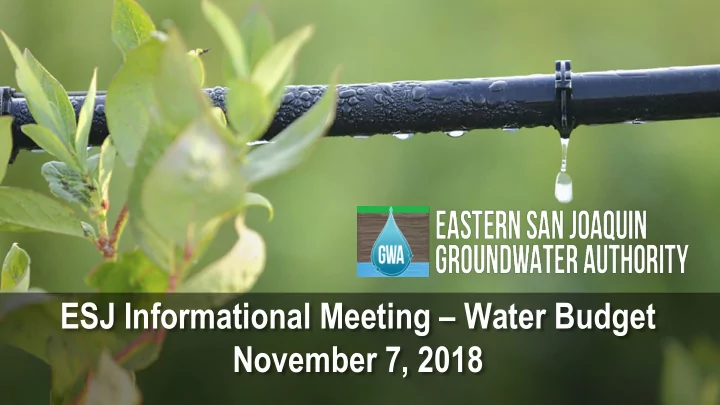

ESJ Informational Meeting – Water Budget November 7, 2018
Water Budget
What is a Water Budget? A Water Budget is an accounting of the total groundwater and surface water entering and leaving a groundwater basin. 3
A Water Budget Operates like a Bank Account Inflows (supplies) and outflows (demands) are tracked and compared over time to identify change in amount of water stored. Outflows Inflows 4
Water Budgets Quantify the Movement of Water A Water Budget takes into account the storage and movement of water between the four physical systems of the hydrologic cycle: • Atmospheric system • Land surface system • River and stream system • Groundwater system 5
Why are Water Budgets Important? • “You can’t manage what you don’t measure” • A series of ongoing negative balances can result in long-term conditions of overdraft (the ESJ Subbasin is currently classified as “critically overdrafted ”) • Carefully calculated Water Budgets increase the likelihood that planned projects and management actions will achieve the intended outcome within the intended timeframe 6
The Water Budget for the ESJ GSP Pulls Combines Land and Water Use Cropping Patterns & Irrigation Practices Rainfall Water Demand and Supply Land & Water Use Budget 7
Water Budget Time Frames Current Historical Projected Conditions Water Water Baseline Budget Budget Uses the most recent Uses historical Uses estimated future data on population, information for population growth, land use, temperature, temperature, land use changes, year type, and precipitation, water climate change, and hydrologic conditions year type, and land sea level rise projected out over 50 use going back a projected out over 50 years of hydrology. minimum of 10 years. years of hydrology. 8
Water Demands are Based on Urban and Agricultural Water Use Estimates • Urban water use based on: • Population • Water Use Per Person • Agency projections • Agricultural water use based on • Crop type and acreage • Soil conditions • Irrigation practices • Hydrogeology and climate 9
Urban Water Demand: Changes in Use Over Time 1995 2015 10
Historical Simulation: Estimated Annual Urban L&WU Budget 11
Historical Agricultural Water Demand: Changes in Crop Type Over Time 12
Historical Simulation: Estimated Annual Agricultural L&WU Budget Eastern San Joaquin Subbasin Average Annual Estimated Agricultural Water Budget (Historical Conditions: 1995-2015) 13
Historical Simulation: Estimated Annual Groundwater Budget Water Out Water In 14
Current Conditions Baseline: Urban L&WU Budget 15
Current Conditions Baseline: Agricultural L&WU Budget 16
Current Condition Baseline: Groundwater Budget 17
Projected Water Budget Approach Step 1 Identify future demands through 2040 Step 2 Identify supply projects with yield and timing Step 3 Develop water budget from “current” (2016) to 2040 18
Projected Future Conditions: Land Use and Cropping Patterns Historical Period Projected Future Period 2040 19
Projected Future Conditions: Estimated Population and Water Use 2040 2040 Historical Historical Period Projected Future Period Period Projected Future Period *GPCD = gallons per capita per day 20
Projected Future Conditions: Estimated Surface Water Deliveries Historical Period Projected Future Period Historical Period Projected Future Period 21
Water Resources Model
Water Resources Model Over the past decades, agencies in the Eastern San Joaquin Subbasin have worked together to build, calibrate, validate, and refine an integrated surface- and groundwater model that serves as a robust and defensible analytical tool to support GSP development. ESJWRM Eastern San Joaquin Water Resources Model 23
The Model Was Approved for Use by the Groundwater Authority Board of Directors During the May 9, 2018 Groundwater Authority Board meeting, the Board voted to approve the use of the model in the GSP development process. The Model will be used to develop the Water Budget and evaluate Projects and Management Actions. 24
The Model was Developed Based on an Existing DWR Modeling Platform and Local/Statewide Datasets Migration of Existing Extract Information from DYNFLOW (local ESJ C2VSim-FG (state model of Subbasin model) Data Central Valley) ESJWRM 25
The Model Captures the Interplay Between Integrated Hydrologic Processes Land Surface Processes Groundwater Flow Streamflow Physical Systems Integration Water Budgets 26
Hydrologic and Hydrogeologic Computations are Performed at Model Grid Elements and Nodes • Model Grid • 16,054 elements • Average Area: 76.5 acres • 15,302 nodes • Node Spacing: • Across Model Area: 0.37 mile • Along the Rivers/Water Courses: 0.28 miles 27
The Model Simulates Major Surface Water Features Model Boundary Streamflow and surface water diversions are simulated, as well as groundwater-surface water interactions 28
The Model was Built Using Data Going Back to 1922 Calibration Period: 1995-2015 Model Period: 1965-2015 29 *Source: PRISM (Parameter elevation Regression on Independent Slopes Model)
How Will the Model be Used? Identify GW Basin Conditions Model Develop Short-Term Operations Conduct Long-Term Planning 30
What Questions Can the Model Answer? The model will help answer some of the big SGMA questions. How long will it What are the take to achieve economic sustainability? What are our implications of thresholds for sustainability? sustainability? What is the current status of the groundwater How is basin? sustainability measured? 31
ESJ Informational Meeting – Water Budget November 7, 2018
Recommend
More recommend